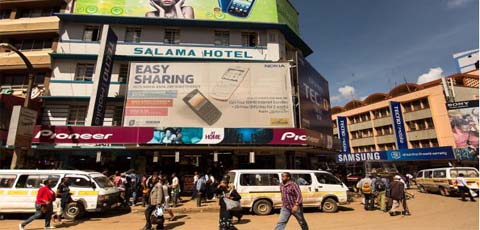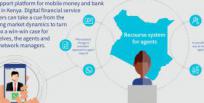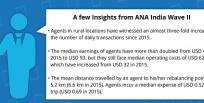
This blog was originally posted on the CFI Accion Blog.
The Helix Institute of Digital Finance recently launched the Kenya Country Report 2014 as part of their Agent Network Accelerator (ANA) project. The ANA project is aimed at increasing global understanding of how to build and manage sustainable digital financial services (DFS) networks by conducting large-scale research among DFS agents and issuing training to providers and other stakeholders. In this two-part interview, Dorieke Kuijpers, Research Project Manager at the Helix Institute and co-author of the report, provides insight into the ANA project and the Kenya Country Report.
The new Kenya report focuses on the operational determinants of success in agent network management. By way of background, can you give an overview of these components and tell us about the scope of this survey?
The country report is based on 2,128 mobile money agent interviews carried out in 2014 across Kenya. For the survey, we partnered with Research Solutions Africa (RSA), a research firm that has vast experience working in several African countries. After undergoing an intensive training by MicroSave’s lead researchers, the team of enumerators recruited by RSA conducted the several-thousand interviews with mobile money agents spread throughout the country. The findings of the survey resulted in the Kenya 2014 Country Report as well as five (confidential) reports that present providers with an overview of provider-specific findings.
The questionnaire that we used focuses on five operational determinants of success in agent network management, or pillars, as we call them. Both our country reports and our provider reports are based on these pillars. The first pillar, agent and agency demographics, helps us develop an agent profile at the country level and covers indicators such as the age of an agency and the proportion of dedicated and exclusive agents. Core agency operations is the crux of the research as this pillar looks at the health of an agency—e.g. the products and services offered, the number of daily transactions, the types of transactions conducted, and the average value of transactions. Liquidity management looks at an agent’s liquidity practices and needs and how these affect their daily transaction levels. The pillar quality of provider support analyzes the extent to which service providers support their agents in terms of trainings and refresher trainings, monitoring visits, and availability of call centers. Lastly, business model viability assesses the financial strength of an agent.
How does Kenya’s agent banking network compare to other countries? Aside from its high customer uptake figures, what are some of the ways the Kenyan agent network stands out?
We find that in many ways, bank agents in Kenya are offering additional services as opposed to competing with mobile network operator (MNO) agents, which is quite unique. For example, more bank agents than MNO agents offer money transfer services and bill payment. In addition, bank agents in Kenya offer their customers the opportunity to deposit savings to a bank.
Our industry has placed a lot of emphasis on whether agents are managed by a bank or a mobile network operator. In Kenya, there are indeed a lot of differences between these two types of models, but in some of the other countries we have studied – in particular India, Pakistan and Bangladesh – the bank branch penetration is higher and banks have more customers than the banks in Kenya. Their approach to DFS is different than that of banks in Kenya and is more akin to the approach used by telecom companies in Kenya. In our India Country Report 2014, we provide insights on the differences between existing models and their approaches in India.
The Agent Network Accelerator project includes assessments carried out in eight countries across Africa and Asia. Along with these efforts, what else is included in the ANA project?
The ANA project is the largest research project on agent networks in the world and has set out to conduct detailed assessments in eight countries (Uganda, Tanzania, Kenya, Nigeria, India, Indonesia, Bangladesh, and Pakistan), twice, over a period of four years. With the continued support of the Bill & Melinda Gates Foundation, we have already conducted over 22,500 agent interviews. In addition to Kenya, we will be conducting second rounds of research in Tanzania and Uganda this year.
Beyond completing the second round of surveys in the eight countries over the next two years, we are expanding the project in three important ways: 1) benchmarking research processes and survey rationalization; 2) geographical expansion within Africa; and 3) developing new training courses.
Our research team is constantly benchmarking its processes to ensure we keep delivering quality research that meets the industry’s best practices. At the moment, we are developing a rigorous automated process to our quality control systems in the field, and we are increasing the capacity of our analysis team. Additionally, we’re working on standardizing our questionnaires even more in order to make them more replicable. Another development on the research front includes the expansion of the ANA project: in collaboration with the United Nations Capital Development Fund (UNCDF), we are conducting Agent Network Assessments and training courses in Zambia and Senegal this year. The assessment in Senegal will be the first one we carry out in West Africa. We look forward to gaining a deeper understanding of the DFS markets in this region and how they compare to the East African and South Asian markets. With the support of existing and additional supporters, we hope to continue expanding our research to other countries and regions.
The extensive data gathered through the ANA research forms the foundation for the training courses that we offer. By combining the research with hands-on field visits and conversations with practitioners that built successful agent networks, we ensure practitioners leave our training with the competitive advantage needed to accelerate their agent networks. In addition to our Core Agent Network Accelerator (CANA) training, we piloted a new course in August, Product Development Accelerator (PDA) course, aimed at training providers in adopting a customer-centric approach when developing new DFS products.











